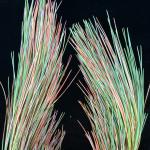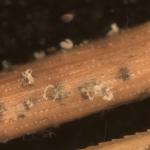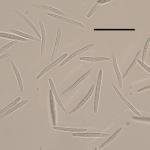Septorioides Needle Blight
Pathogen
Septorioides needle blight is caused by the fungal pathogen Septorioides strobi (Wyka and Broders 2016).
Hosts
Eastern white pine (Pinus strobus) is the primary host of S. strobi in southern New England. However, based on samples submitted to the UMass Plant Diagnostic Laboratory, additional hosts include Swiss stone pine (P. cembra), lodgepole pine (Pinus contorta var. latifolia), limber pine (P. flexilis), mugo pine (P. mugo), Austrian pine (P. nigra), ponderosa pine (P. ponderosa), red pine (P. resinosa), pitch pine (P. rigida), Scots pine (P. sylvestris), Japanese black pine (P. thunbergii), and red spruce (P. rubens). Other members of the Pinaceae may serve as hosts, but infections are presumably uncommon.
Symptoms & Disease Development
Septorioides is one of the primary pathogens responsible for white pine needle damage (WPND) in New England (Broders et al. 2015, Wyka et al. 2018) and is the most common needle blight pathogen found on P. strobus samples submitted to the UMass Plant Diagnostic Laboratory. First documented in 2009, WPND is a chronic stress for eastern white pines throughout eastern North America. Infection by Septorioides most often develops as a needle tip blight where the base of the needle remains green. Over time, the entire needle becomes yellow-brown to brown and is prematurely shed from the canopy. Many other soft (five-needle) and hard (two- & three-needle) pines frequently used as ornamentals can serve as hosts. In southern New England, infected trees appear scattered on the landscape and encompass all age classes. Like many needle blight fungi, S. strobi produces large volumes of spores that are blown and splashed to nearby branches and trees during wet weather. Climate studies have shown the northeastern U.S. is experiencing an increase in the frequency and amount of precipitation during the months of May, June and July, which is helping to fuel outbreaks of WPND (Wyka et al. 2017). The May–July period is when WPND pathogens, such as S. strobi, are most actively sporulating and older, diseased needles are shedding from the canopy. This coincides with the period of active needle and shoot development for many pines in the region. These immature needles are most susceptible to infection during periods of wet weather or high humidity. Once infected, symptoms may take many months to develop and may not be visible until the following spring, nearly one year after infection. However, at times, symptoms develop more quickly and may be observed shortly after infection.
Management
Active management for any needle blight pathogen of conifers should focus on protecting the current year's foliage from becoming infected in the late spring and early summer. Pruning of heavily diseased branches, especially those in the lower canopy, and removal (or covering) of discarded needles can help to reduce disease pressure. Forest studies have shown a direct correlation between thinning density and needle blight severity. When diseased pines are provided more space, light and airflow, needle blight severity decreases. Fungicides that should have some utility include azoxystrobin, benzovindiflupyr, copper hydroxide, mancozeb, metconazole, phosphites and thiophanate-methyl. Applications should be made on regular intervals from mid-May to early July as new needles are elongating. Even minor rain events may provide the necessary moisture for spore dispersal and germination. Needle blight fungi can have long latent periods before symptoms develop. Therefore, needles may be infected for many months before they become symptomatic. Symptoms from infection by Septorioides appear to develop more quickly, however, sometimes appearing during the summer and autumn after infection. Overall, much remains unknown about this pathogen and its association with eastern white pine. For more information on eastern white pine health, see here: https://ag.umass.edu/landscape/fact-sheets/dieback-of-eastern-white-pine
References
Broders K., Munck I., Wyka S, Iriarte G., and Beaudoin E. 2015. Characterization of fungal pathogens associated with white pine needle damage (WPND) in Northeastern North America. Forests 6: 4088–4104. https://doi.org/10.3390/f6114088
Wyka S.A. and Broders K.D. 2016. The new family Septorioideaceae, within the Botryosphaeriales and Septorioides strobi as a new species associated with needle defoliation of Pinus strobus in the United States. Fungal Biology 120: 1030–1040. https://doi.org/10.1016/j.funbio.2016.04.005
Wyka S.A., Smith C., Munck I.A., Rock B.N., Ziniti B.L., and Broders K. 2017. Emergence of white pine needle damage in the northeastern United States is associated with changes in pathogen pressure in response to climate change. Global Change Biology 23: 394–405. https://doi.org/10.1111/gcb.13359
Wyka S.A. Munck I.A. Brazee N.J., and Broders K.D. 2018. Response of eastern white pine and associated foliar, canker and root rot pathogens to climate change. Forest Ecology and Management 423: 18–26. https://doi.org/10.1016/j.foreco.2018.03.011






